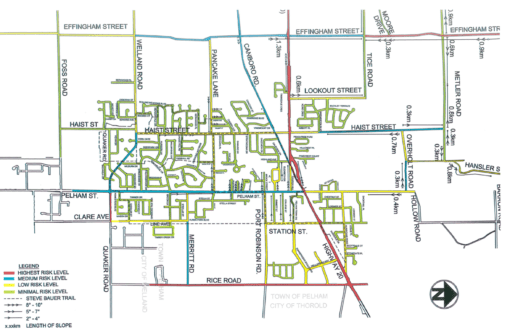Ask not for whom the slope tolls...
BY JOHN SWART VOICE Correspondent
Funny thing about the walkers in Fonthill. If one were to monitor their meanders, it would become apparent that the majority use routes primarily following the contours our “hill,” rather than up and down. There are six walkers and their dogs, sniffing and lifting their legs (the dogs, not the walkers) along Spruceside Crescent, Hurricane Road, or the rail bed section of the Steve Bauer Trail, for every one climbing Church Hill or east Canboro Road.
Ditto that for the runners. Sure, it's scenic running along Foss Road or Welland Road, but it's also much more flat than Haist Street or Effingham Road as you head north.
 Nothing elicits immediate muscular and mental mutiny like approaching a serious hill on foot. Even the drowsiest early-morning brain knows its aerobic system will be tested; knees, ankles and especially hip joints will be stressed like Cirque-du-Soleil performers; and calves and glutes are in for overtime.
Nothing elicits immediate muscular and mental mutiny like approaching a serious hill on foot. Even the drowsiest early-morning brain knows its aerobic system will be tested; knees, ankles and especially hip joints will be stressed like Cirque-du-Soleil performers; and calves and glutes are in for overtime.
Even the most energetic dog will sniff a few extra hydro poles or trees at the bottom of a hill, surreptitiously attempting to postpone the ascent.
The catch is, walking or running hills provides major health benefits.
Climbing hills resembles resistance training, in that your muscles must “lift” you up the hill. Resistance training, strength training, or weight training—doctors will use all three terms interchangeably to motivate you—is the use of resistance to normal muscle contraction to build the strength, endurance and size of muscles. Within reason, the more resistance, the better. Hence, the bigger the hill, the better.
Think of flat as maintenance versus hills as improvement. At some time beginning in our 30s, we all start to lose muscle mass, or size. Walking, or gentle running, can help reduce this muscle loss, but for most of us in our 50s, 60s, or beyond, this train has left the station. We've already lost a significant amount of muscle.
Good-news flash—those muscles can be rebuilt with resistance exercise, like hills. And, you might ask, having not fully bought into this idea as you grab your car keys to drive from Station Street to uptown Fonthill, "Why would I care about more muscles and resistance training?"
Reduced symptoms of osteoarthritis, diabetes, osteoporosis, back pain, and depression, weight management, improved balance, better sleep and glucose control might be a few reasons.
Let’s, in our wildest imagination, assume you’re thinking, “Okay, maybe I’ll try it.” How do you begin? Gradually is the key.
Having your spouse drop you off at the bottom of Saylor's Hill, then climbing it to get home, isn't likely the best plan for your first day. For most of us, gradually means short climbs of 2% or 3% grades like Haist Street or Pelham Street North in town.
Good form or the lack of it, whether walking or running, can make a big difference on hills too. Resist the urge to put your head down and tough your way up. Instead, head back, chin up, and chest out will maximize your breathing efficiency. Stare the enemy in the eye, don’t watch your feet.
Shorten your stride so there's less lifting in each step, and if you're running, don't hesitate to intersperse your uphill run with some walking the first few times out.
Beware of downhills. They’re seductive devils, begging you to use the lazy advantage gravity offers. Downhills will stretch your quads unbelievably quickly, which you will feel the next morning. The faster you go, whether walking or running, the more you pound your muscles and joints. Try to avoid using longer downhill strides until you're accustomed to the extra strain.
Fitness and health aside, the best part about being able to walk or run hills is getting out of town into Effingham and Short Hills. Hansler Road is the most charming country lane in Niagara. The washout won't stop you from enjoying a loop of Sulphur Spring Drive, Luffman Drive, and Orchard Hill Road on foot, where massive displays of trilliums should be blooming soon.
My neighbour Steve and his Golden Retriever Jake were beginning their daily walk when I met them at the foot of their driveway. Jake's tail wagged like a flag in a hurricane, anticipating his walk. Last year was busy for Steve, and finding the time for them to get out had been difficult. Jake was the sumo wrestler of Goldens by Christmas.
Both looked good now though, and Steve mentioned he'd dropped two belt sizes. Jake had lost an incredible 17 pounds this spring. I asked how far they walked each day, and Steve said eight kilometres. He then added that after their walk together, he does another five kilometres without Jake.
I couldn't help but notice that at the end of the street, they turned up Haist. ♦



